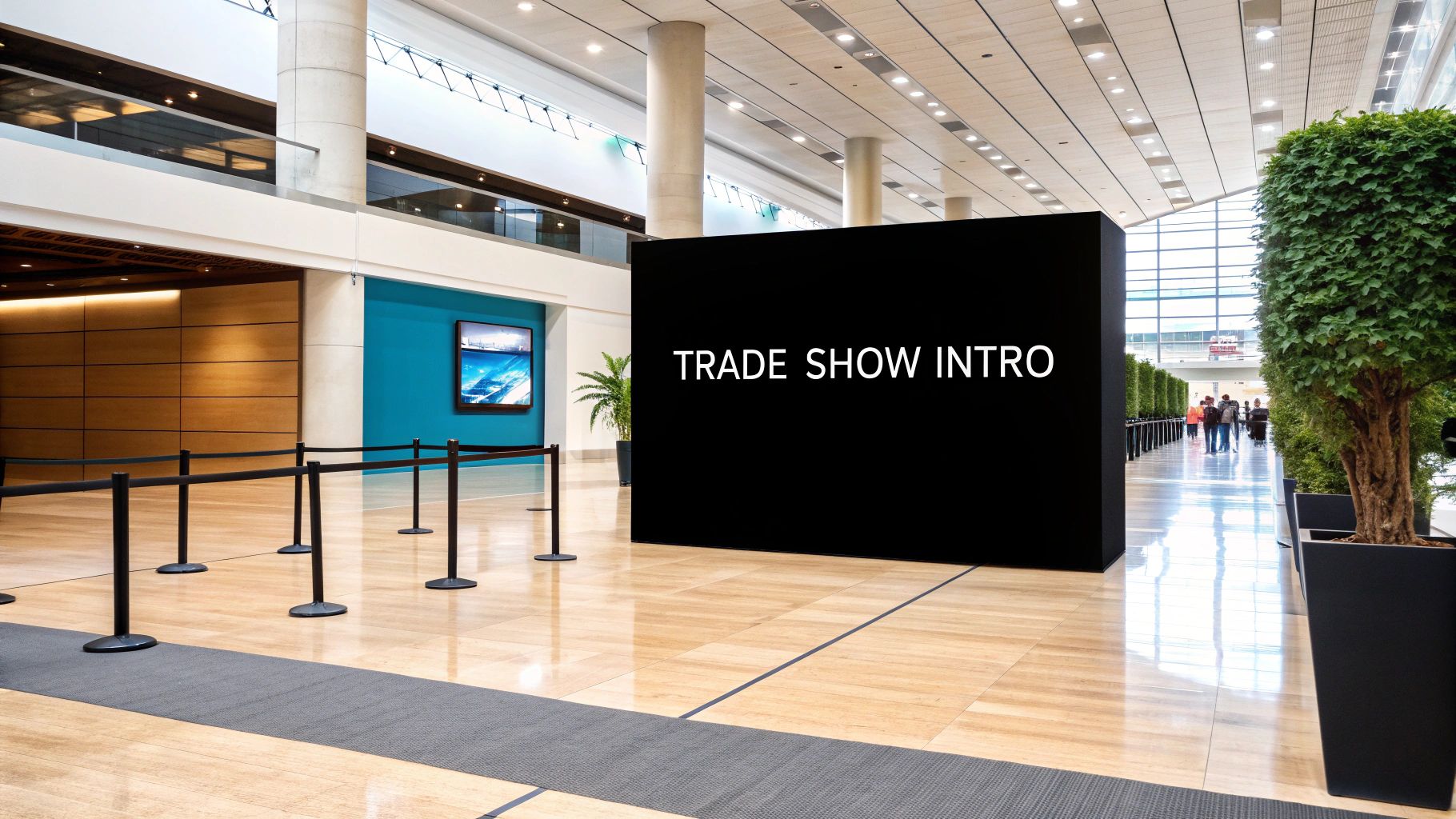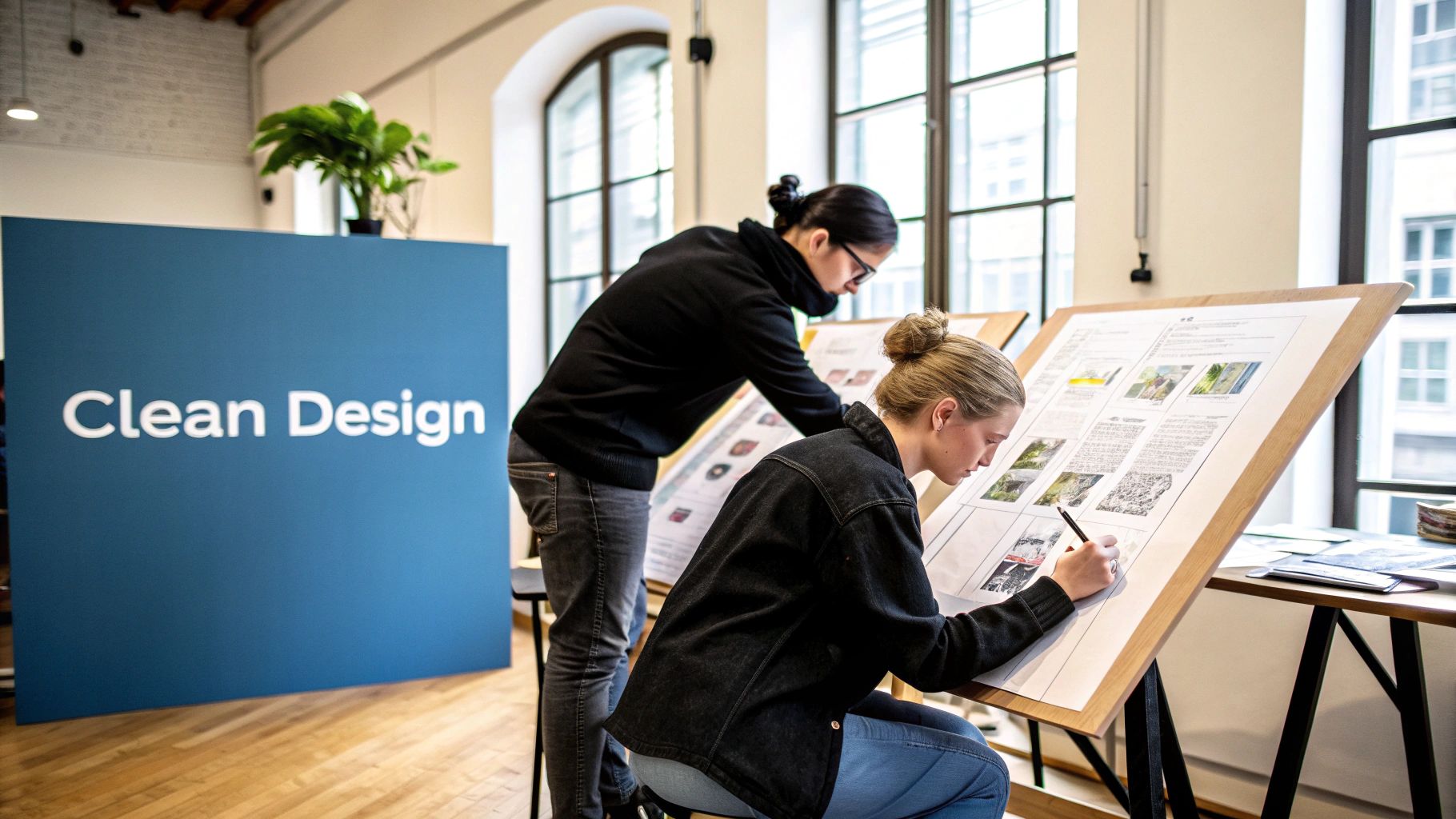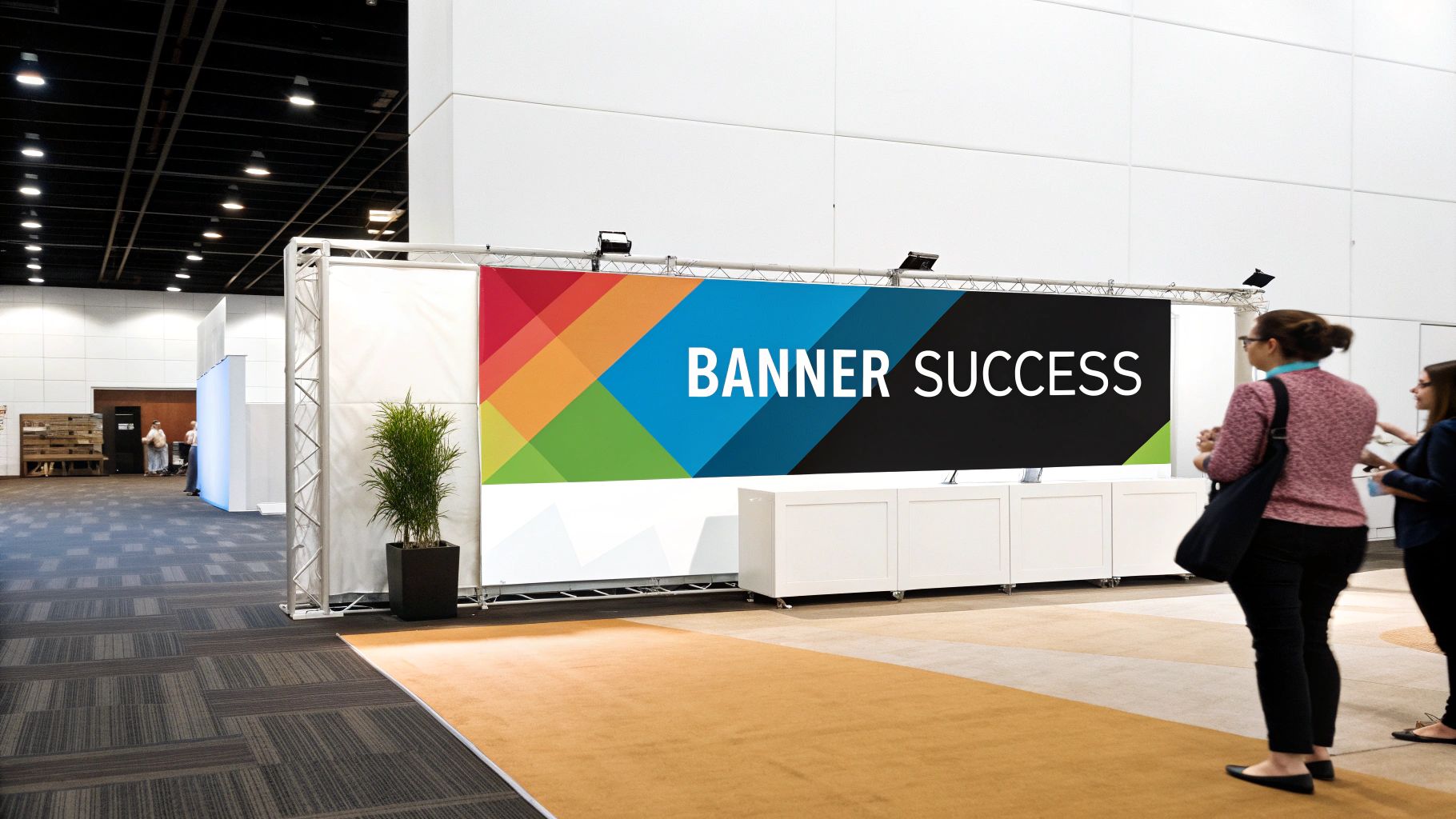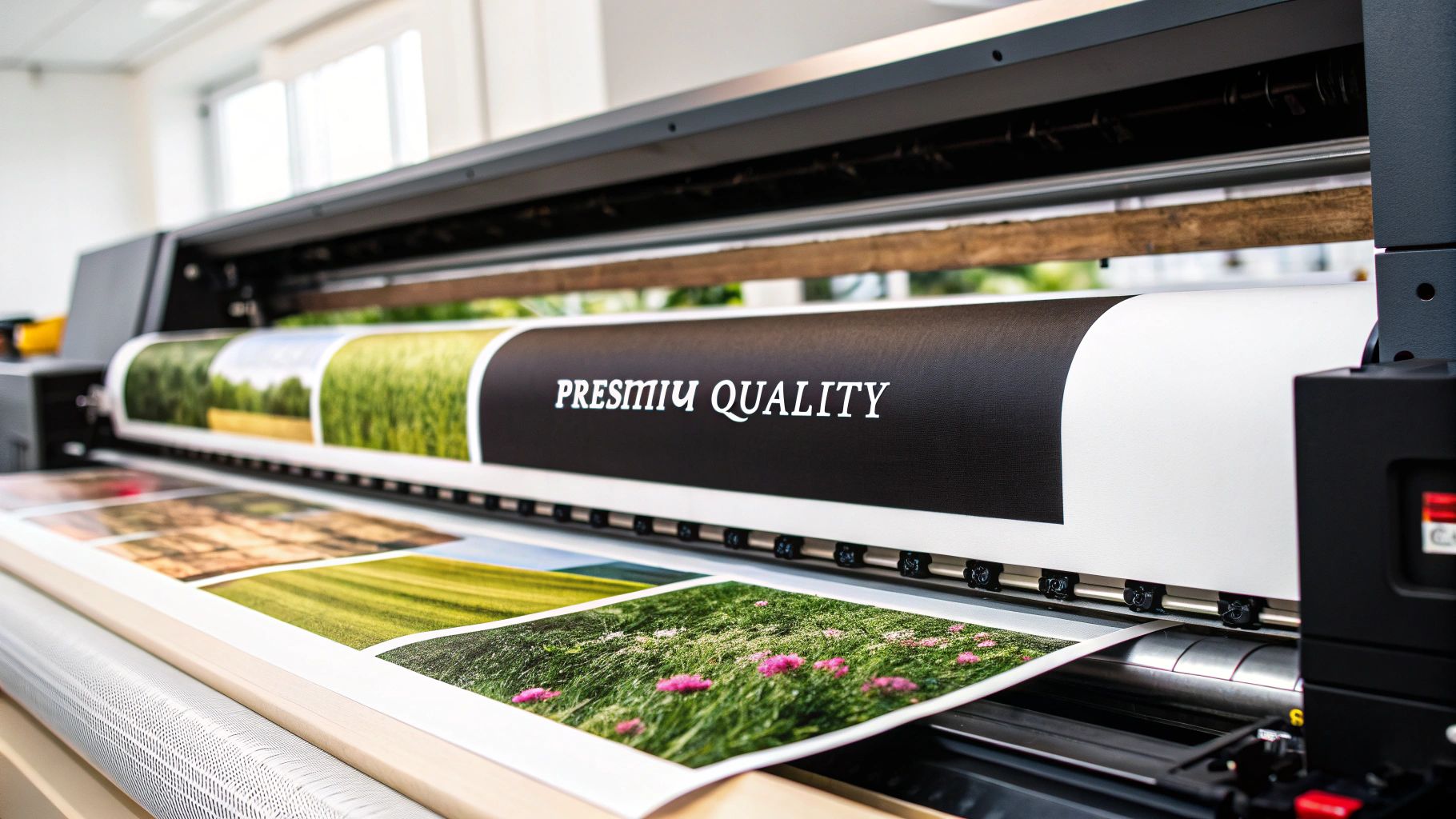Stand Out with a Powerful Trade Show Banner
Why Trade Show Banners Drive Brand Impact

In the competitive environment of trade shows, a well-designed banner can be a company's secret weapon. It attracts attendees and creates a memorable impression, acting as a silent salesperson. These banners are much more than simple backdrops; they are powerful tools that can significantly boost brand impact. Strategic design and placement are key to maximizing their effectiveness.
The Psychology of Visual Marketing
Effective trade show banners leverage the principles of visual marketing. They employ compelling graphics and concise messaging to quickly grab attention and communicate brand value. A banner featuring a striking image and a clear, concise headline can instantly convey a brand's core message, even amidst the hustle and bustle of a busy trade show floor. This rapid communication is vital for establishing a positive first impression.
Strategic Placement for Maximum Impact
The placement of your banner significantly influences its effectiveness. High-traffic areas, such as entrances, aisle corners, or demonstration zones, ensure maximum visibility. Consider using hanging banners, especially in larger venues, to attract attention from a distance. Strategic placement helps turn casual glances into genuine engagement with your brand.
Consistent Messaging Reinforces Brand Recognition
Maintaining consistent visual messaging across all your banners strengthens brand recognition. This cohesive approach creates a professional and unified brand experience for attendees, enhancing memorability and recall long after the event concludes. This lasting impact is essential for fostering long-term business relationships.
Market Growth and the Role of Banners
Trade show banners play a vital role in the broader printed signage market. This market, valued at approximately $43.28 billion in 2024, is projected to reach $51.72 billion by 2033, growing at a CAGR of 2%. Learn more about the Printed Signage Market. Within this market, the Banner & Backdrop segment is predicted to hold a substantial share, growing at a CAGR of 1%, highlighting the continued importance of banners in promotional strategies.
Banners as Cornerstones of Event Strategy
Successful brands recognize that trade show banners are crucial elements of their overall event strategy. They understand that banners are essential for attracting attendees, generating leads, and driving sales. This understanding translates into careful planning and investment in banner design, making these displays integral to a cohesive and effective trade show presence.
Measuring the Impact
Measuring the impact of your trade show banners is crucial for optimizing future event strategies. Track key metrics such as attendee engagement, lead generation, and brand recall to gain valuable insights into banner effectiveness. This data helps businesses refine their design and placement strategies for subsequent events, ultimately maximizing their return on investment. Through thoughtful design and strategic implementation, trade show banners become powerful brand ambassadors.
Designing Trade Show Banners That Stop Traffic

Creating a truly captivating trade show banner involves more than just following brand guidelines. It requires a strategic approach rooted in design principles and an understanding of attendee behavior. This includes carefully considering elements like color psychology, text-to-image ratios, typography, and current design trends. The goal is a banner that not only attracts attention but effectively communicates your brand's message. Trade show banners play a key role in building and reinforcing brand recognition, a crucial element of any successful marketing strategy. Learn more about increasing brand awareness.
The Power of Color Psychology
Color has a profound impact on emotional responses, influencing attendee behavior and decisions. For instance, blue often signifies trust and stability, while green can represent growth and innovation. Understanding these subconscious connections helps you choose a color palette that aligns with your brand message and resonates with your target audience. It’s equally important to consider the venue’s overall color scheme to ensure your banner truly stands out.
Balancing Text and Imagery
The right text-to-image ratio is essential for maximum visual impact. Too much text can overwhelm viewers, while too little might leave them unclear about your message. A good guideline is to prioritize impactful visuals. Limit text to a concise headline, a brief subheadline (if needed), and a clear call to action. This balance ensures your message is quickly and effectively communicated, regardless of the viewing distance. Also, consider the sightlines from various areas of the trade show floor when determining font sizes and image scaling.
Typography for Readability
Font choice significantly affects readability, especially in the sometimes challenging lighting conditions of exhibition halls. Sans-serif fonts, known for their clean lines, like Arial or Helvetica, tend to be more legible from a distance than serif fonts. Adequate font size and sufficient contrast between the text and background are also crucial. This ensures your message remains clear and accessible, even from across a crowded room.
Current Design Trends for Enhanced Engagement
Keeping up with design trends can significantly enhance your banner’s effectiveness. Incorporating modern elements can make your brand appear innovative and relevant, increasing attendee engagement. Examples include minimalist designs, geometric patterns, and interactive elements like QR codes. It’s essential, though, to balance these trends with your core branding to maintain a consistent brand identity.
To help understand the impact of these design elements, take a look at the table below:
To help illustrate the impact of these elements, let's examine a breakdown of their effectiveness:
| Design Element | Attention Score | Message Retention | Conversion Impact |
|---|---|---|---|
| Compelling Imagery | High | Medium | High |
| Concise Messaging | Medium | High | Medium |
| Bold Colors | High | Low | Medium |
| Clear Call to Action | Medium | Medium | High |
| Modern Typography | Medium | High | Low |
| Interactive Elements (QR Codes) | High | Low | High |
This table highlights the importance of combining various elements for optimal results. For example, while bold colors grab attention, concise messaging is key for retention. Interactive elements and compelling visuals can drive conversions when paired with a clear call to action.
Avoiding Common Design Pitfalls
Learning from others' mistakes can save you valuable time and resources. Cluttered layouts, excessive text, and low-quality images are common banner design flaws. These can detract from your message and weaken your brand presence. Also, failing to align your banner design with your overall marketing strategy can result in a fragmented brand experience. Avoiding these pitfalls ensures a positive and lasting impression.
Selecting Materials That Elevate Your Message
The material you select for your trade show banner plays a significant role in its overall impact. It influences not only the visual appeal, but also the durability and lifespan of your investment. Therefore, material selection is a crucial step in the banner design process. Let's delve into the characteristics of different materials and their performance in various trade show settings.
Vinyl: A Durable and Adaptable Option
Vinyl remains a popular choice for trade show banners because of its durability and versatility. It's resistant to wrinkles and tears, making it well-suited for repeated use and transportation. Moreover, vinyl offers excellent print quality, allowing for vibrant colors and sharp images. This makes it perfect for displaying complex designs or high-resolution photographs.
Fabric: Lightweight and Stylish
Fabric banners, often constructed from polyester or tension fabric, provide a more refined and sophisticated appearance. They are lightweight and easy to transport, which helps reduce shipping expenses. Furthermore, fabric banners can be machine-washed, simplifying maintenance and keeping them looking pristine. This is a significant advantage for companies attending multiple trade shows throughout the year.
Eco-Friendly Choices: Sustainable Alternatives
For environmentally conscious businesses, recyclable banner materials are increasingly available. These options enable companies to minimize their environmental footprint without compromising quality or visual impact. Some of these materials are crafted from recycled plastics or offer biodegradable alternatives, aligning with corporate social responsibility objectives. This reflects a growing movement toward sustainable practices within the trade show industry.
Cost vs. Longevity: Finding the Right Balance
Selecting the right banner material requires balancing initial costs with long-term value. While some materials might have a higher upfront price tag, their durability and reusability can lead to significant savings over time. For example, a premium vinyl banner might cost more than a basic fabric banner initially. However, if the vinyl banner endures numerous trade shows, it can be more economical in the long run. Therefore, it's important to consider the frequency of use and the overall expected lifespan of the banner when making a decision.
Material Performance: Adapting to Different Environments
Different materials react differently to various lighting conditions. Some materials may produce glare under bright exhibition lights, while others retain their vibrancy even in natural light. Matte finishes can minimize glare, while glossy finishes enhance color saturation. Understanding these subtle differences is key to selecting a material that effectively conveys your message in your trade show's specific lighting environment.
Expert Advice: Insights from Event Professionals
Seasoned event professionals often stress the importance of logistical considerations, such as shipping and setup, when choosing banner materials. Banners that are frequently transported and assembled benefit from being durable, lightweight, and easy to set up. This minimizes wear and tear and reduces labor costs associated with assembly and dismantling. These practical insights can be extremely valuable in extending the life of your trade show banner.
By carefully evaluating these factors, you can choose the ideal material for your trade show banner. The right material enhances your message, strengthens your brand presence, and creates a memorable experience for attendees.
Matching Banner Types to Your Strategic Goals

Selecting the right trade show banner is a critical decision, dependent on your specific marketing objectives. Whether your goal is a new product launch, increased brand awareness, or driving booth traffic, your banner choice plays a vital role. Consider factors such as visibility, attendee flow, and even your competitors' displays.
Banner Types and Their Ideal Uses
Different banner styles are suited to different scenarios. A retractable banner, for instance, offers portability and quick setup—ideal for smaller booths or events where space is limited. Fabric displays provide a polished look, perfect for creating an impactful backdrop. Let’s examine some popular banner types and their strategic uses:
-
Retractable Banners: These cost-effective, portable, and easy-to-assemble banners are ideal for showcasing key messages, promotions, or new product details in a limited area.
-
Fabric Displays: Known for their vibrant colors and smooth finish, fabric displays are great for boosting brand awareness and creating an immersive booth experience. They are particularly effective as backdrops or large-format visuals.
-
Hanging Structures: Maximize visibility in crowded venues with hanging banners. These suspended displays attract attention from a distance, helping attendees easily locate your booth.
-
Backwalls: Create a cohesive and professional look with a backwall. These large backdrops provide ample space for branding, messaging, and product showcases, anchoring your entire booth presence.
Real-World Examples: Strategic Banner Placement
Leading brands strategically select banner types based on their goals and target audience. A company launching a new product might utilize a large hanging banner to generate excitement and attract attention across the trade show floor. Smaller retractable banners within the booth can then highlight specific product features and benefits. This layered approach caters to both distant and close-up viewers.
Guiding the Attendee Experience
Strategic banner placement guides attendees through a designated journey within your booth. Direct traffic flow, emphasize product areas, or even create interactive zones using strategically positioned banners. A directional banner can lead attendees to a product demo area, while an engaging backwall display can serve as a backdrop for presentations. This curated experience boosts engagement and creates a lasting impression.
Choosing the Right Banner for Your Budget
Industry, budget, and team resources are also key factors in banner selection. For smaller businesses with limited budgets, a retractable banner or a well-designed pop-up display offers excellent value. Larger corporations might opt for elaborate backwalls or custom hanging structures to create a strong brand presence. Prioritizing quality and design ensures maximum impact, regardless of budget.
To help you visualize the differences between banner types, we've compiled a comparison table:
Trade Show Banner Types Comparison: A comprehensive comparison of different trade show banner types by cost, setup time, durability, portability, and impact.
| Banner Type | Cost Range | Setup Time | Durability | Portability | Visual Impact |
|---|---|---|---|---|---|
| Retractable Banner | Low-Medium | Quick (minutes) | Moderate | High | Medium |
| Fabric Display | Medium-High | Moderate | High | Medium | High |
| Hanging Structure | Medium-High | Moderate-High | Moderate | Low | High |
| Backwall | High | High | High | Low | High |
This table highlights how various banner types balance cost, practicality, and visual appeal. Selecting the right balance maximizes your investment and effectively communicates your brand message.
Measuring Your Trade Show Banner's True ROI

Moving beyond gut feelings about your trade show presence, it's essential to accurately measure the return on investment (ROI) of your banners. This means understanding how your banner contributes to both immediate results and long-term business growth. Let's explore how to quantify the impact, from lead generation to boosting brand image. This helps justify the expense and refine future trade show strategies.
Attribution Models: Connecting Banners to Outcomes
Attribution models are key to linking your banner investment to specific outcomes. You can track leads generated through QR codes on your banner or monitor website traffic from a unique URL printed on the display. This data provides valuable insights into how effectively your banner drives engagement and conversions, connecting your banner to measurable results.
Integrating Digital Touchpoints for Measurable Results
Forward-thinking brands are enhancing banner engagement by integrating digital touchpoints directly into their designs. This involves incorporating QR codes, NFC tags, and links to specialized landing pages directly on the banner. These digital touchpoints allow you to capture leads, track engagement, and create measurable conversion paths, creating a seamless attendee experience and providing valuable data.
Calculating Comprehensive ROI: Beyond Direct Sales
Calculating the complete ROI of your banner goes beyond just direct sales. It includes the value of increased brand awareness, improved competitive positioning, and stronger relationship development. These factors, while challenging to quantify precisely, contribute significantly to long-term growth. A well-designed banner can leave a lasting impression, influencing purchasing decisions long after the event.
Trade shows, where banners are essential, are a significant part of the exhibitions industry. The global exhibitions market, valued at $44,150.1 million in 2024, is projected to reach $66,749.9 million by 2033, growing at a CAGR of 4.7%. Find more detailed statistics here. This growth highlights the continued importance of trade shows and the vital role banners play.
Benchmarks for Banner Refresh Cycles: Maximizing Lifespan
Maximizing your banner's lifespan is a key aspect of ROI. Refresh cycles should be based on campaign needs and wear and tear. Regular maintenance and proper storage can extend its life, reducing the need for frequent replacements and ensuring you get the most from your investment. A banner for a specific product launch might only be needed briefly, while a general branding banner can be used for multiple events with proper care.
Practical ROI Frameworks and Metrics
A practical framework for measuring banner ROI involves tracking several key metrics:
-
Website traffic from banner-specific URLs: This measures direct response to calls to action.
-
Leads generated via QR codes or landing pages: This quantifies potential customer interactions.
-
Social media mentions and engagement related to the banner: This tracks brand awareness and online conversation.
-
Post-show surveys about brand recall and booth experience: This gauges the banner's lasting impact.
By tracking these metrics and implementing digital tools, you gain valuable insights into banner performance and can make data-driven decisions, leading to more effective designs and a higher return on investment.
From Design To Show Floor: Execution Excellence
The journey of a trade show banner, from finalized design to its impactful display on the show floor, involves crucial production steps. These steps, often overlooked, go beyond simply printing. They ensure your vision translates into a high-quality, durable banner that effectively represents your brand. Let's explore these essential elements of flawless trade show banner execution.
Choosing The Right Print Partner
Selecting a print partner shouldn't be based solely on price. Look for a printer with a proven track record of delivering consistent, high-quality results. Ask for work samples, especially of trade show banners, and client testimonials. A reliable print partner understands the specific demands of trade shows, such as the need for vibrant, durable prints that can withstand travel and setup.
Time-Tested Production Timelines
Rushed production often compromises quality and increases costs. Establishing realistic production timelines is essential. Work backward from your event date, factoring in design approvals, printing time, and shipping. A seasoned print partner can advise on standard lead times and help you create a schedule that avoids last-minute problems. For example, allowing ample time for revisions and proofing avoids costly reprints.
Protective Packaging: Preventing Shipping Damage
Your banner needs to arrive undamaged. This requires protective packaging. Discuss appropriate options with your print partner. These options might include sturdy tubes for rolled banners, padded cases for fabric displays, or custom crates for larger, more complex structures. Proper packaging protects your investment and prevents costly on-site delays or replacements.
Setup Protocols For A Pristine Appearance
Even with durable materials, proper setup is crucial for maintaining your banner's pristine appearance. Carefully follow the manufacturer's instructions. For example, ensure proper tension on retractable banners and avoid excessive handling of printed surfaces. Experienced exhibitors often have setup protocols that minimize damage and ensure a professional look, even after multiple uses.
Storage Best Practices For Longevity
Proper storage significantly impacts your banner's lifespan. Store rolled banners in their protective tubes, away from direct sunlight and extreme temperatures. Fabric displays should be carefully folded or hung to prevent wrinkles. A dedicated, climate-controlled storage area can further extend your banner's life, preserving its visual impact for numerous events. To understand the full impact of your banners, explore data and analytics, much like measuring the ROI of other marketing initiatives.
Comprehensive Checklist For Execution Excellence
Use a comprehensive checklist to ensure every detail is covered:
- Initial artwork preparation requirements
- Print partner selection criteria
- Agreed-upon production timeline
- Protective packaging specifications
- Setup and takedown instructions
- Post-show quality assessment
- Recommended storage procedures
This checklist provides a roadmap for flawless execution, maximizing your banner investment's impact and longevity.
Ready to elevate your trade show presence? Pilot Exhibits offers premium, modular displays designed to make your brand stand out. Our innovative, tool-free solutions simplify setup and reduce labor costs. Learn more at Pilot Exhibits.





